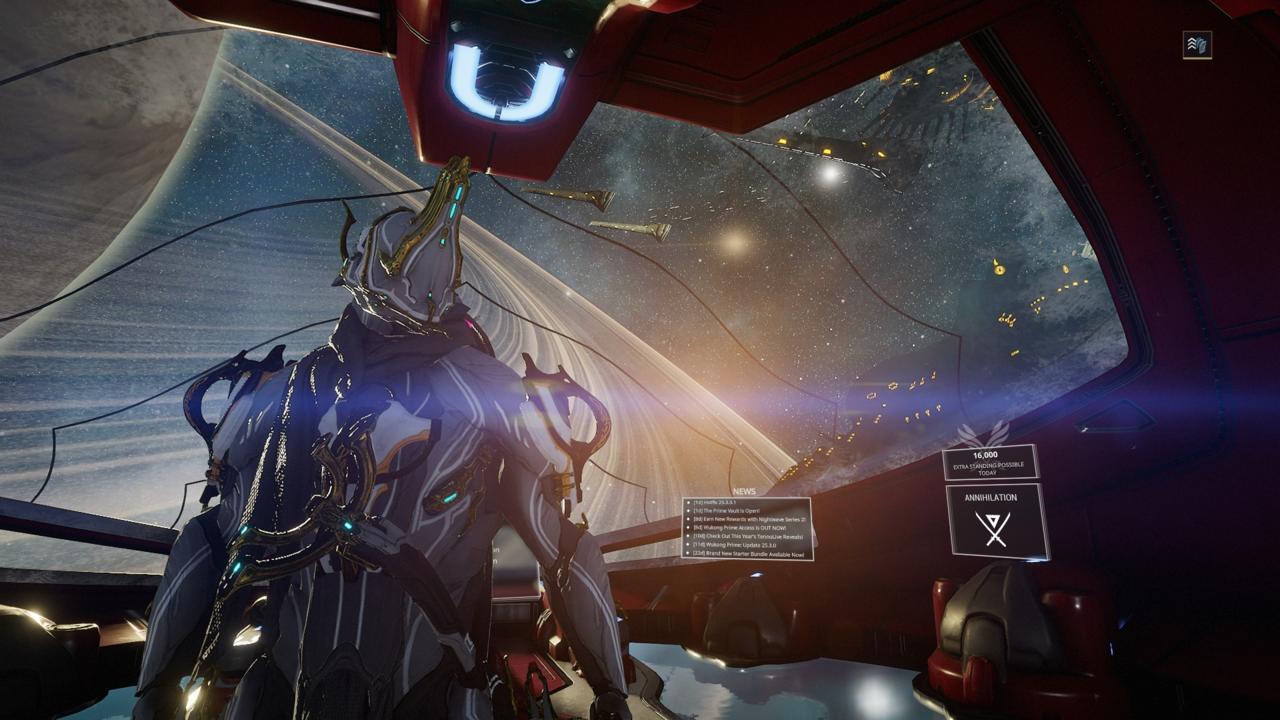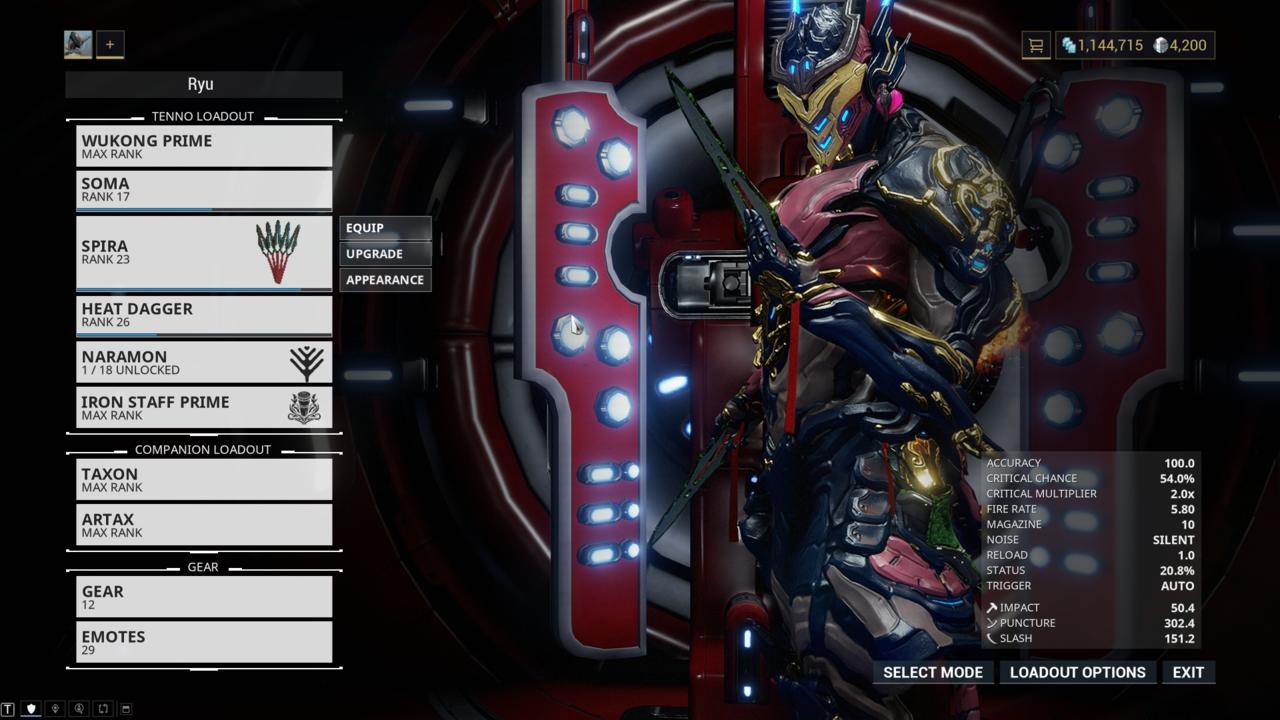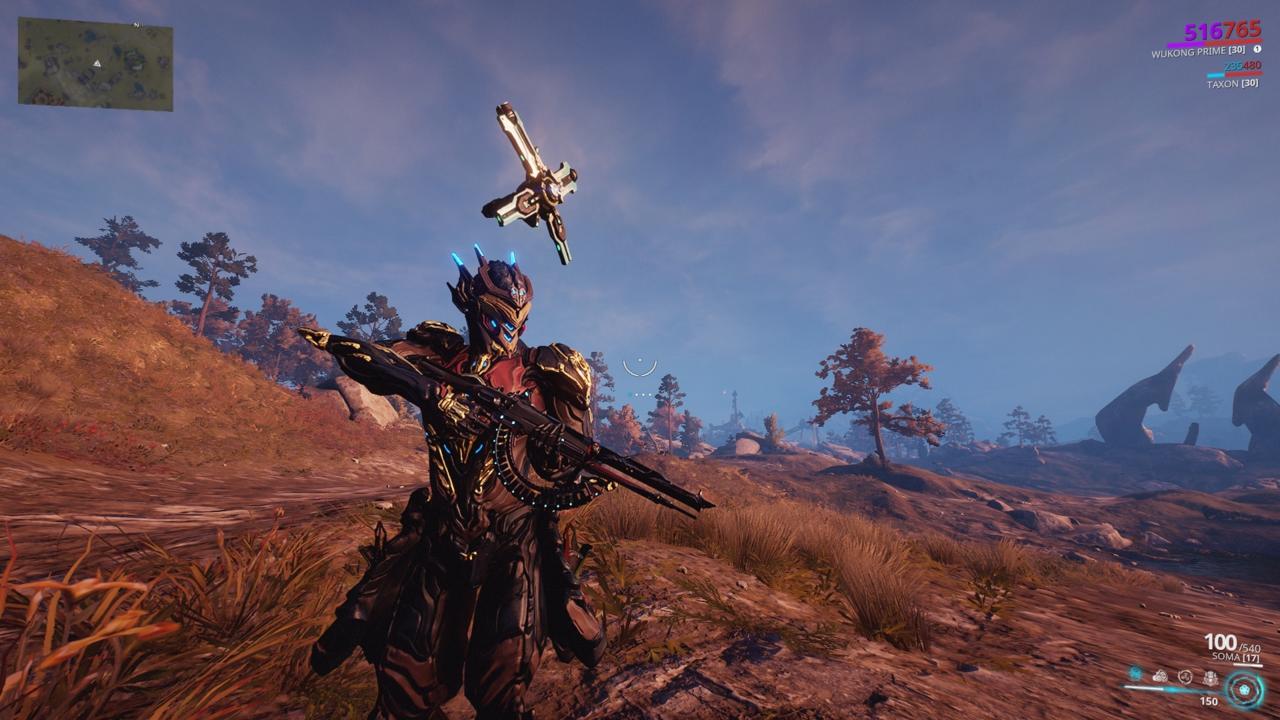Editor's note: GameSpot originally reviewed Warframe in 2013 and gave it a 6. Due to substantial revisions and new content since its debut, we have re-examined Warframe as it is in 2019 and produced a new review to reflect its current state.
Update (February 1, 2021): Digital Extremes' Warframe is out on PS5. This current-gen version of Warframe sticks closely to its PS4 counterpart, even offering cross-save and crossplay functionality between both versions of the game. What's new with the PS5 edition are improved visuals that run at 4K and 60fps and added haptic features with the DualSense controller. This in turn gives a greater sense of visual and gameplay feedback in combat and the general action of the space-faring adventure, which is one of the most compelling aspects of playing Warframe.
This improved presentation and flow is closer to the leading PC version than the PS4 version was. What's more, various UI and graphical options can be tuned to your liking to optimize your game, allowing you to engage dynamic resolution, adjust the field of view, or even tweak minor graphics options. At times, the PS5 version can struggle to maintain a stable frame rate when you're playing with a full squad of players, which can lessen the flow in a fast-paced mission. With that said, the experience of hacking, slashing, and traversing across Warframe's expansive universe on PS5 is a clear upgrade over the PS4 version. As it stands, the PS5 edition of Warframe offers a fantastic way to play the massive online action-RPG on a console. -- Alessandro Fillari. Our updated Warframe review, first published in 2019, continues below.
To play Warframe is to reconcile yourself with the sensation that you're always a bit in over your head. Even six years after its debut, it's still something of an oddity within the realm of online action-RPGs. With an expanding universe housing a wealth of content, the free-to-play game offers a stellar amount of freedom to explore, uncover loot, and take on missions with its cast of stylish space ninjas. It takes a decidedly unorthodox approach with its non-linear adventure--sometimes frustratingly so--yet journeying across Warframe's massive universe is as satisfying as it is endearing.
In GameSpot's original 2013 review, we praised the game's agile and hard-hitting combat but criticized the lack of meaningful features that effectively took advantage of those strengths. In the broader sense, the Warframe of old was a promising sketch of an idea that lacked reasons for investment. The Warframe of today, however, has filled out the bigger picture. Its vision is clearer, and it's now so much more than just space ninjas brawling in corridors. Some of Warframe's best moments involve venturing into the realms of deep space, exploring open worlds and, yes, engaging in combat to power up and take on greater challenges.

When it comes to its gameplay and narrative, Warframe always seems to chuck you into the deep end. The larger story focuses on an interstellar clan of warriors known as the Tenno as they reacquaint themselves with a grander universe in perpetual conflict. You take control of a reawakened Frame--revitalized Tenno fighters from the distant past--to engage in missions against a myriad of enemy factions. This conceit of spacefaring ninjas slashing and shooting across the universe holds the loose narrative together while also giving you an impressive amount of freedom. Several cinematic quests shed light on the history of the Tenno, leading up to some profound moments that reveal a surprising depth for your character and their place in the galaxy.
Warframe is a massive game with numerous, complex systems to dive into--but therein lies the rub. It's a challenging game to crack; even with hundreds of hours under my belt, I can still feel overwhelmed by how much game there is to unpack. However, the trick to understanding this game lies within finding your own focus in the nebulous grind--whether that's taking on a variety of side-activities and missions on a series of planets or investing time to customize, experiment, and tweak your favorite Frames.
It can often feel like playing catch-up, considering there is six years' worth of content in the package, but it's a game that rewards taking the time to soak it all in, instead of rushing through. How you get accustomed to this surprisingly sink-or-swim structure will determine the mileage you get out of it. Most missions are singular, discrete encounters across the solar system. This piecemeal structure ultimately makes the massive game more digestible. There's a staggering amount of activities to dive into, and with over 40 hyper-stylized Frames to utilize, there's a constant sense of fun and surprise when discovering how deep it all runs. However, while the opening missions do well to get you into the basic swing of things when it comes to its core gameplay, the more in-depth systems are left for you to decipher on your own.
The overall speed and flexibility in its action is something that it continually excels at, and there's a constant sense of grace and finesse that can make even the ordinary missions thrilling.
This mostly hands-off approach in getting you acclimated can sometimes manifest feelings of aimlessness. And it's magnified when it becomes apparent that there isn't a traditional endgame to work up to. There are higher-end missions and stories designed for more experienced players, some focusing on endless fights against waves of enemies, but there isn't anything like raids to unlock later on. In many ways, you're introduced to that familiar endgame grind from the onset, and that often entails fine-tuning your suite of Frames to tackle many of the game's tougher challenges.
The true star of Warframe are the various Frames, with each possessing their own unique designs and abilities. The pursuit of new characters to play as is one of the many constants in your journey, often dictating where you should invest your time. It always feels rewarding when you find a new Frame, especially when it's one that stands apart from the others. Some are highly specialized, such as the stealth-oriented Ash or the aquatic, alien-tentacle-summoning Hydroid. Another standout is Octavia, a Bard-like Frame that lets you craft custom music to amplify your abilities and attack enemies. One time, a squadmate of mine used Octavia's skills to effortlessly clear a hallway full of enemies--all to the tune of Salt-N-Pepa's "Push It."
There is a ridiculous amount of room to experiment, and it can be especially fun strengthening one of the beginner Frames with powerful mods and armaments that can melt through enemies. It's also impressive how in-depth customization and personalization is in Warframe--you can apply different shaders, accessories, and even alter their particular animation set, and it's rare to find another player who has the same style and loadout.
It's a necessity to get your Frame to reach its potential for them to be viable for more advanced activities. If you don't apply the correct mods and buffs to your character, it can often stop you in your tracks at some inconvenient moments in your progression. If you're committed to figuring out the intricacies of the game, then using online guides to understand these advanced mechanics, much like with other aspects of the game, is a must. These resources are a big help, but it's disappointing how often you have to use them, as opposed to the game teaching you the same information. Without them, learning these systems on your own can be a significant test of patience.
You'll quickly find yourself in a rhythm of cutting down mobs of enemies and boosting your Frame's strength by collecting mods and earning experience as new gameplay systems and events open up. While the core gameplay is often satisfying, it's still common to see a streak of highly repetitive missions, most of which re-use tile-sets for procedurally-generated levels and objective types. This repetition can create a recurring feeling of déjà vu throughout, and there were times when this left me feeling exhausted after an extended play session with the game.
To help ease this sense of repetition, Warframe does inject a number of variations on standard missions, as well as adding in new activities. Along with Nightmare challenges, harder versions of previously completed levels, several missions even remix past stages by including multiple enemy factions within one level, making some standard objectives far more hectic. Some objectives feature totally different gameplay modes, in particular incorporating the Archwing, which switches up the familiar action sequences with Wing Commander-style shooter levels. There's even a set of PvP game types, such as the Conclave and Duel modes, with the latter letting you invite another player to a player-made clan dojo to engage in a solo fight. Unfortunately, the PvP activities come across as exceedingly basic and clunky compared to the core PvE experience.

Despite how much the game has grown over the years by adding in game-changing features, Waframe's roots are still planted firmly in its fast-paced and satisfying core combat. The overall speed and flexibility in its action is something that it continually excels at, and there's a constant sense of grace and finesse that can make even the ordinary missions thrilling. It often shows similar shades to a fast-paced corridor shooter by way of a stunning character-action game, with your squad tearing through enemies using myriad skills and armaments.
The core combat and general traversal of Warframe can move at a blistering pace. Despite how complex they can get, they're still intuitive enough to dive into, and you can pull off Warframe's advanced acrobatics like gliding, wall-runs, and the appropriately named "Bullet Jump"--which darts your character in any direction--reasonably quickly. Melee combat also features its own complexities, allowing you to use an assortment of combos and aerial abilities to cut through legions of foes in flashy display. Over time, chaining together slick parkour leaps into fast strikes with your weapons can become second nature, resulting in Warframe's most gratifying and stylish encounters.
Warframe can be daunting for newcomers, yet it can also prove a challenge for players--like myself--who take an extended break and have to learn the basics of new features while simultaneously unlearning outdated ones. Such is the case for online games, and fortunately, Warframe does have an active and open community to trade with and seek assistance from, and you can directly interact with others at various social spaces across different planets. It's common that you might have to consult outside resources in order to figure out what to do next, or else your progress might come to a halt abruptly.

Stick with the game long enough, and you'll unlock access to the more involved cinematic story missions and open-world settings that best show the game's considerable growth. Unlike the fragmented storytelling in most of the game, these two pillars present a more guided plot that offers memorable narrative and character moments. Some of these missions even include the surprising addition of a dialogue system, which can result in some slightly different events in questlines.
In the open-world settings of the Plains of Eidolon and the Orb Vallis, which open after you reach the planets they're located on, you can take in the sights of the large-scale worlds, take on dynamic bounties and events with squads, and even learn more about the brewing conflict within each setting. The Vallis' story is especially engaging, dealing with workers' rights and the perils of late-stage capitalism in the interstellar age. Though these main stories set in the open worlds tend to end far too quickly, the amount of nuance and narrative packed in was impressive, which left me wanting to spend more time in the settings to continue interacting with its characters.
I'm continually pleased with the flexibility of Warframe's many systems, and how it allows for you to attain a variety of rewards and unlocks at your own pace. Of course, there is an assortment of items, weapons, and even Frames to purchase with real money or with Platinum, Warframe's premium currency. Fortunately, most items in the game are attainable through gameplay, allowing you to get into the nitty-gritty of the game's content mostly unabated. The in-game economy of Warframe is very active, and if you're resourceful enough, you can even trade some of your own gear and blueprints with other players for Platinum as well.

When new content is introduced, the pathway to experiencing the quests or acquiring the next Frame is available to all players. This relaxed approach is reassuring, especially for a game of this magnitude. I generally find acquiring gear and new classes to be quite manageable. However, there are still some time-sinks that feel mostly arbitrary, resulting in the expected and sometimes lengthy grind that's commonplace in free-to-play games. To that end, the primary intent of Platinum is to circumvent both investments of time and resources.
Thinking back to GameSpot's original review, it's interesting how much the game has improved, yet also how much has stayed the same. The game still has issues with repetition and lack of explanations for its more complex systems, but it's managed to overcome their severity by introducing so many events and revisions that continue to elevate it. While there are inevitable bouts of frustration here and there, I always manage to center myself once I move on to other opportunities. In a lot of ways, that's what Warframe manages to do best. One moment you're taking part in a random spy mission on Saturn, and the next, you're partnered up with a powerful squad of players that help you through several void fissures. Just when you feel like you've hit a lull, a better, and more fulfilling opportunity will likely present itself. Perhaps most importantly, Warframe makes sure that the time spent in its world is almost always well rewarded.



















